Tulips are well-known flowering plants that thrive primarily during cold weather conditions and require low maintenance. When it comes to fertilizing the tulips, many gardeners consider coffee grounds. But are coffee grounds good for tulips? Let’s find this out.
Generally, you can use coffee grounds for tulips as it can boost the growth of tulips. However, excess application of coffee grounds can increase the acidity level of soil, burning the roots of your plant. Thus, it would be best if you used coffee grounds with caution.
Today I will explain the best ways of using coffee grounds on your tulips and what you should avoid doing if you are using them.
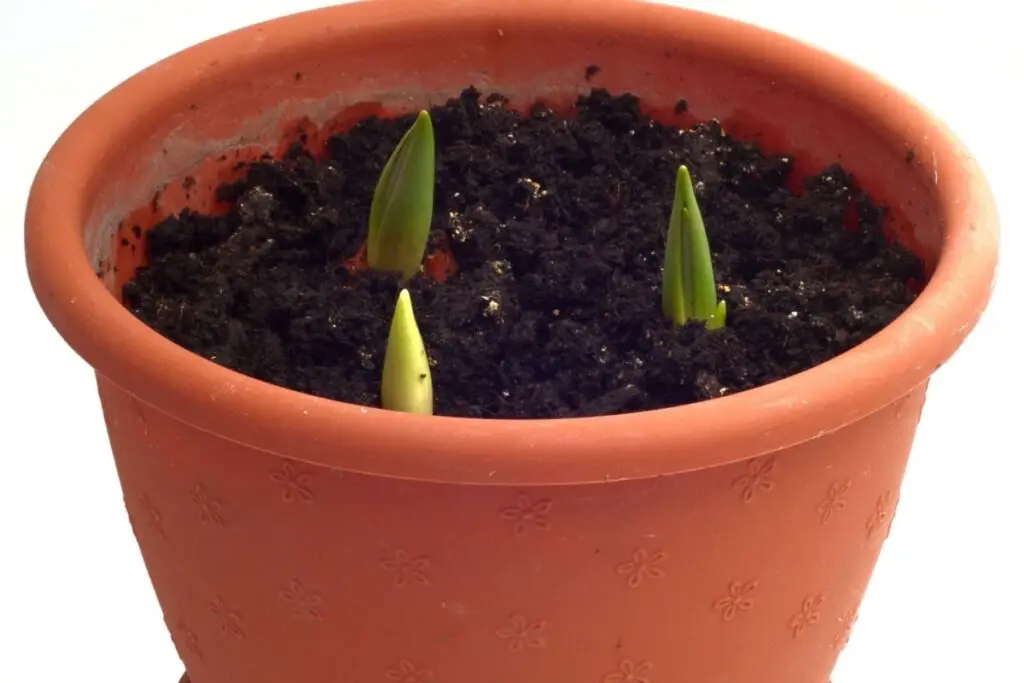
Are coffee grounds good for tulips?
Coffee grounds are primarily used for those plants which prefer acidic soil for growing. Tulips require slightly acidic soil, so adding too many coffee grounds can cause damage.
Tulips prefer slow-release fertilizers because they don’t need too many nutrients in one go. They need small amounts of nutrients over time.
Coffee grounds are considered slow-release fertilizers containing almost all kinds of nutrients tulips need, making them a good choice for these flowering plants.
However, an increase in the acidity of the soil can cause a problem for tulips. Make sure you always test the soil pH level before adding coffee grounds to avoid further problems.
Tulips prefer a pH level range between 6.0 and 7.0, which is quite close to neutral.
After planting, the soil automatically becomes acidic from time to time, so you need to check the soil pH level before you add coffee grounds.
How often should I put coffee grounds on my tulips?
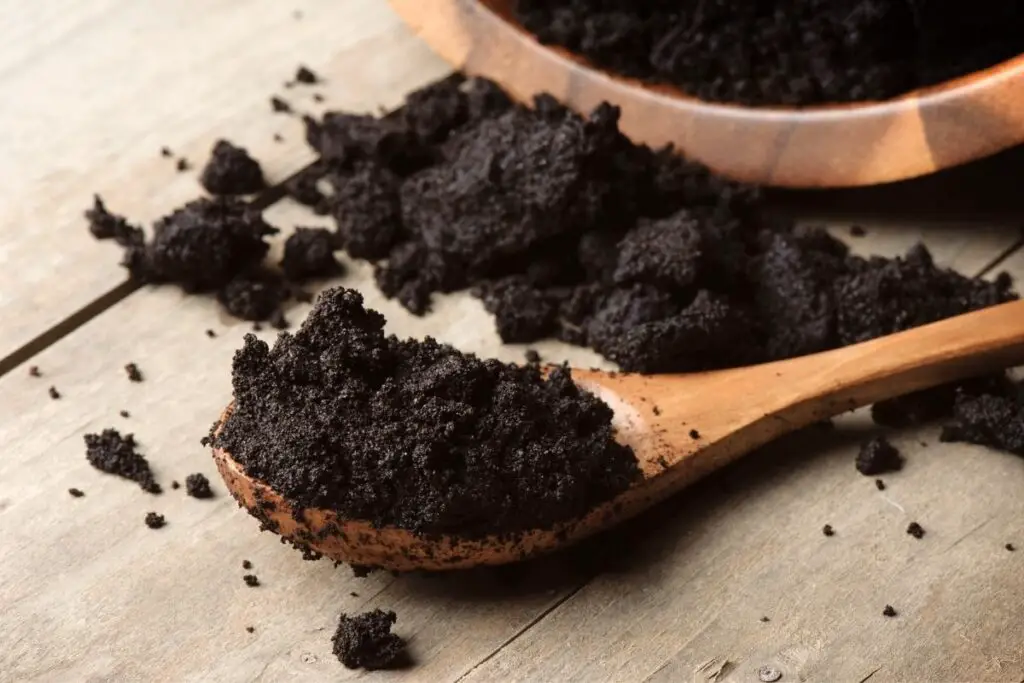
Coffee grounds help to increase the growth of a plant. It contains nitrogen in a high amount that increases the metabolism rate of the tulips.
It boosts the cellular growth of plants. So, it is one of the great choices for nurturing tulips.
Coffee grounds are pretty beneficial for tulips, but it has some disadvantages too. Adding a high amount of nitrogen to your tulips can cause severe damage.
Tulips need fertilizers once a year. The ideal time to fertilize tulips is in the fall. During this time, tulips take up the nutrients in the best possible manner.
Make sure you don’t add coffee grounds to tulips in a high amount as it can increase the soil’s acidity and burn the roots.
If the soil is already acidic, you should avoid adding coffee grounds to tulips as it can stunt their growth and restrict their blooming.
Different ways to use coffee grounds on tulips
Coffee ground is one of the easiest ways to provide nutrients to plants. It can improve the quality of the soil and the strength of tulips.
Adding coffee grounds can help in moisture retention, promote good drainage and provide enough air to the soil to help the roots breathe.
There are various ways to add coffee grounds to tulips for promoting better growth.
For example, you can mix coffee grounds with water to not increase the acidity of the soil. Or you can use coffee grounds as mulch.
Let us find out the best processes of adding coffee grounds to the soil.
Adding coffee grounds as compost
You can mix coffee grounds with the compost to contribute nitrogen to the compost pile. Put a tiny amount of coffee grounds in the soil and cover it well with compost or mulch.
Mixing coffee grounds with compost is one of the best ways to provide nutrients to your tulips. Adding it in a small amount will help tulips take up the nutrients from time to time without the issue of overfertilization.
Because of coffee grounds, worms get attracted frequently to the soil, which helps nutrients break down faster, making the soil more fertile. It helps boost the growth and increase the blooming of tulips.
Avoid adding too much coffee grounds to the compost as excess can increase the acidic level of the soil and can damage the entire roots of the plant.
Things you need to keep in your mind:
- Always check whether you have overwatered your tulips since the mixture of coffee with compost pile can hold water for an extended period and cause overwatering.
- Make sure the compost is light so that the roots get enough air to breathe. Heavy compost will not allow air to pass easily and can cause root rot.
- Using dry leaves and wooden barks will help control the acidity of the soil. So, try to use that instead of marbles and rocks.
Looking for gardening supplies? We have tested 100's of products before recommending them to you guys. Check out our best pick below:
| Image | Gardening Supplies | Best Price? |
|---|---|---|
 Top
Top Top
Top | Raised Garden Bed Kit | Check On Amazon |
 | XLUX Soil Moisture Meter, Plant Water Monitor, Soil Hygrometer Sensor for Gardening, Farming, Indoor and Outdoor Plants, No Batteries Required | No Results |
 Top
Top Top
Top | 82 Pcs Garden Tools Set and Extra Succulent Tools Set | Check On Amazon |
 | Joeys Garden Expandable Garden Hose with 8 Function Hose Nozzle, Lightweight Anti-Kink Flexible Garden Hoses, Extra Strength Fabric with Double Latex Core, (50 FT, Black) | No Results |
 Top
Top Top
Top | Dual Chamber Compost Tumbler | Check On Amazon |
 Top
Top Top
Top | Sunnyglade Plant Stakes | Check On Amazon |
 Top
Top Top
Top | Organic Cold Pressed Neem Seed Oil | Check On Amazon |
 Top
Top Top
Top | Mighty Mint Gallon :-Insect and Pest Control Peppermint Oil | Check On Amazon |
 Top
Top Top
Top | Scotts DiseaseEx Lawn Fungicide | Check On Amazon |
 Top
Top Top
Top | Jacks Classic 20-20-20 All Purpose Fertilizer | Check On Amazon |
 Top
Top Top
Top | 30,000 Seeds Pollinator Attracting Wildflower Mixture | Check On Amazon |
 Top
Top Top
Top | Survival Vegetable Seeds Garden Kit-Over 16,000 Seeds | Check On Amazon |
Using coffee grounds as a liquid fertilizer
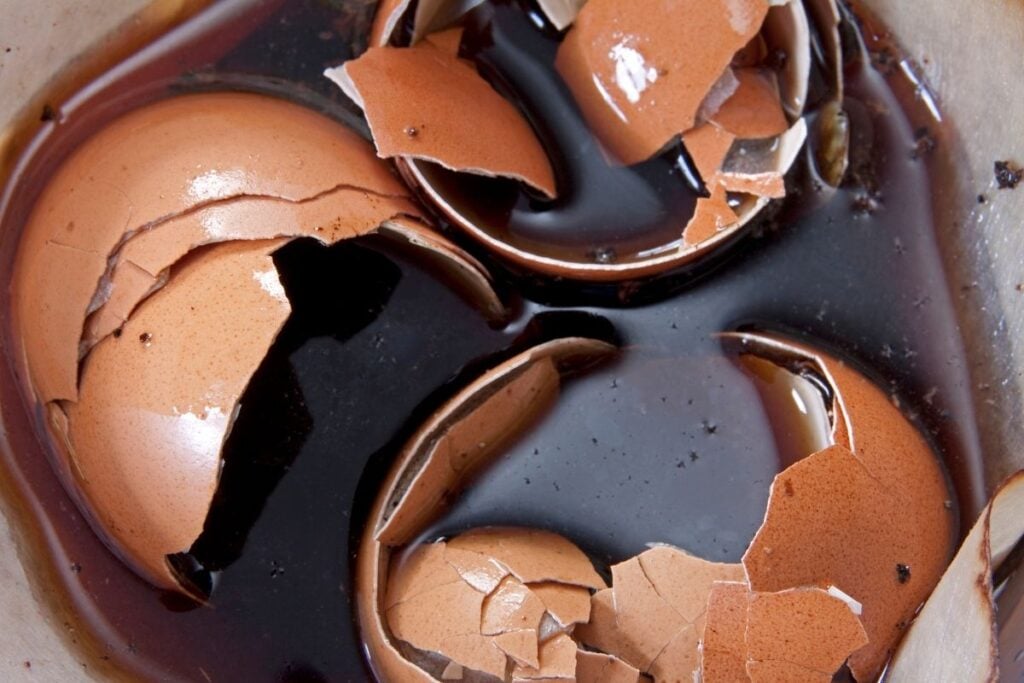
Mixing the coffee grounds with water and using it as a fertilizer is the easiest and suitable way of fertilizing your tulips.
Using coffee grounds as liquid fertilizers also prevents the soil from getting too acidic as diluting it with water reduces the Nitrogen level. This process is not complicated. You just need the right amount of coffee grounds and water.
Adding the coffee grounds directly to the soil can harm your tulips. So, it’s better to put coffee as a liquid fertilizer.
Things you should do for making liquid fertilizer:
- First, take a container and add 2 cups of coffee grounds. Then add the powder to 5 gallons of water.
- Leave the mixture for at least a week so that the nutrients will dissolve entirely in the water.
When the week is over, you can add the prepared liquid fertilizer into the soil.
You can also take a spray bottle with water and mix coffee grounds and let it sit for a few days. After a few days, you can spray the liquid to the tulips’ soil.
Don’t apply this liquid fertilizer frequently as tulips don’t need too many nutrients. Excessive fertilization can damage your plant.
You should always check the soil’s pH level before you add coffee grounds.
After fertilization, if you see your tulips are not blooming or have stunted growth, you should immediately stop using this liquid fertilizer.
As coffee grounds can increase the acidity of the soil, it might damage your plant. Always be careful with the quantity you are using it.
Use a test probe to check the soil and if you have over-fertilized it by any chance, try to remove the extra fertilizer by flourishing as soon as possible.
Adding directly into the soil hole or soil bed
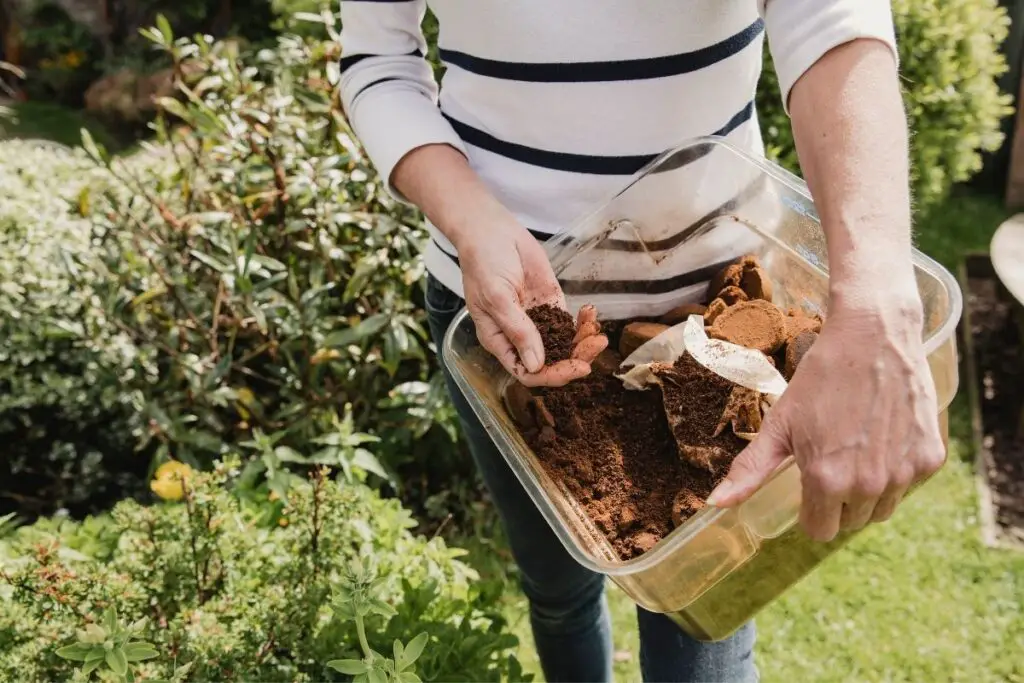
Despite having advantages, there are more disadvantages of adding coffee grounds directly to the soil, so I don’t recommend this. This process is quite risky as it can cause overfertilization.
If you put coffee grounds directly into the soil, the soil’s acidity is bound to increase and can damage your tulips.
If you still consider adding coffee grounds directly to the soil, add a tiny amount to your tulips to avoid overfertilization and the alteration of soil pH.
Advantages of using coffee grounds
Coffee grounds help tulips in many ways. Let’s find out.
Coffee grounds make the soil acidic
Tulips need slightly acidic soil. They prefer soil with 6.0 to 7.0 pH levels. In many cases, the soil becomes too alkaline, which makes it difficult for tulips to grow.
If the soil acidity is low for your tulips, coffee grounds can come in help. Coffee grounds might increase the acidity of the soil and make it suitable for tulips.
Also read: What Kind Of Soil Is Good For Tulips? (Best Soil Mix)
Provide nutrients
Coffee grounds contain many nutrients that tulips need, which makes them a good choice for these plants.
If you want to provide Nitrogen and other nutrients such as Potassium, Phosphorous, and Calcium to your tulips, you can add some coffee grounds.
Also read: What Is The Best Fertilizer For Tulips? (Organic+Inorganic)
Improves soil structure
Coffee grounds also add organic matter to the soil, which helps to improve the soil structure. Because of organic matter, the quality of the soil improves, which allows better water retention and air circulation.
Disadvantages of coffee grounds
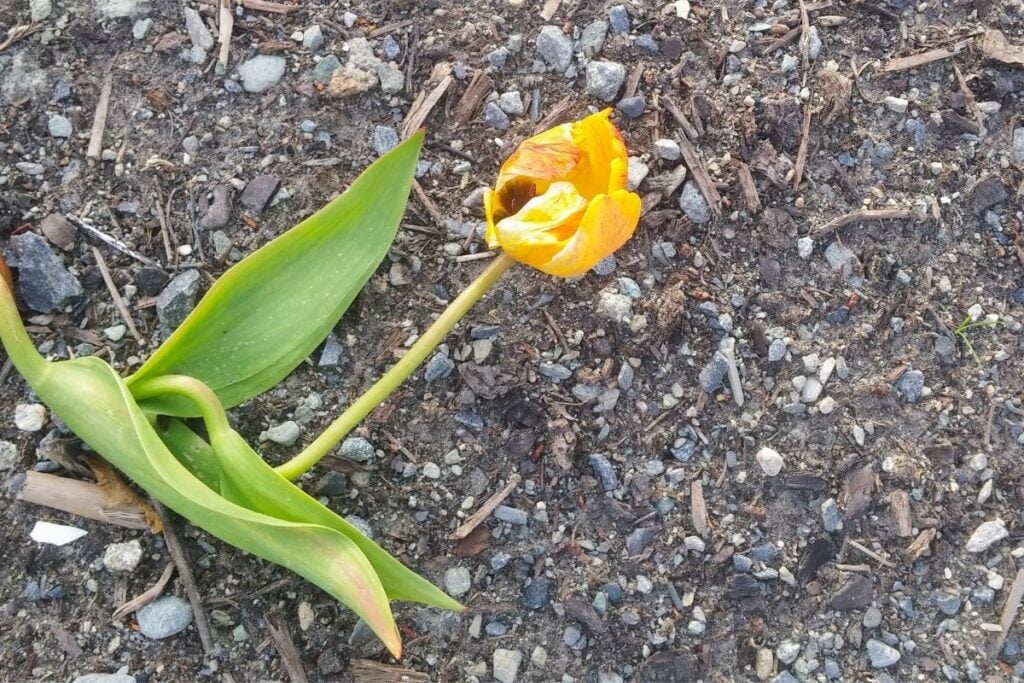
There are a lot of disadvantages to coffee grounds too. If added excessively, it can be harmful in many ways.
Too much coffee grounds will increase the acidity of the soil, due to which nitrogen level in the soil also increases, causing damage to the tulips.
If you notice any strange behavior in your tulips, you must check the soil’s pH level to understand whether it is because of coffee grounds.
Always test your soil before adding coffee grounds to it. You must test the soil at least once or twice per year to avoid future problems.
There are various signs to find out whether coffee grounds are causing any harm to your tulips or not.
Stunted growth
If the acidity of the soil increases, the growth of tulips becomes slow. Due to excessive acidity in the soil, the plant can have stunted growth, and the blooming capacity also decreases.
Always check the soil before using coffee grounds for your plant. If the soil is already acidic, avoid using coffee grounds for tulips.
Leggy growth
Due to excessive nitrogen in the soil, tulips can grow leggy.
Nitrogen is mainly used for boosting up the growth of a plant. Excessive use of coffee grounds can increase the soil’s nitrogen level and make the tulips grow more than required.
Due to this, the tulips become weak and start to fall off. So, try to use less coffee grounds as too much can harm your tulips.
Yellow leaves
If you notice any yellow leaves on tulips, it might be because of acidity in the soil. The correct pH value for tulips is 6.0 to 7.0. If it gets lower than that, the leaves will turn yellow.
If you notice yellow leaves after adding coffee grounds to the tulips, you should check the soil’s pH because the acidity might have increased in the soil.
Moisture retention
Coffee grounds have an excellent capacity for holding moisture for an extended period. Adding too many coffee grounds can increase moisture retention and can cause overwatering.
You should always use well-draining soil for tulips so that the extra water will come out quickly.
Overwatering problems can invite various pests and cause root rot disease, which can directly affect the health of a plant.
How to fix the acidity of the soil?
If your tulips face soil acidity, you can solve this problem quickly without getting worried.
Ways to reduce the acidity in the soil is:
- If the condition worsens, you can transplant tulips in a new garden spot with fresh soil.
- You should check the pH level frequently to maintain the correct pH level for tulips.
- You can add Epsom salt to reduce the acidic level in the soil. Take 1 tablespoon of Epsom salt with 1 gallon of water. Then add this mixture to the soil.
- You can also add alkaline water drops to the soil to make it neutral for tulips.
Final words
After adding coffee grounds to the tulips, you must check whether your tulips are healthy. Always keep an eye on their growth.
If you notice any abnormal or unhealthy growth, immediately test the soil’s pH level and solve this problem as soon as possible.
Adding coffee grounds directly into the soil can be harmful to your tulips as they are sensitive plants. It is best to use them as a liquid fertilizer.
Take good care of your tulips and provide them with adequate water and sunlight with the correct amount of fertilizer.
Source: Wikipedia, North Dakota Stae University, The Royal Horticultural Society.
